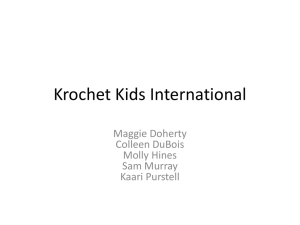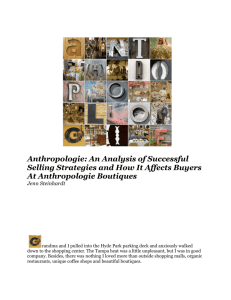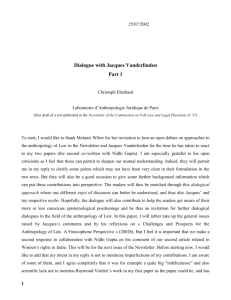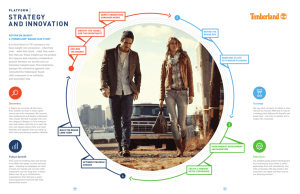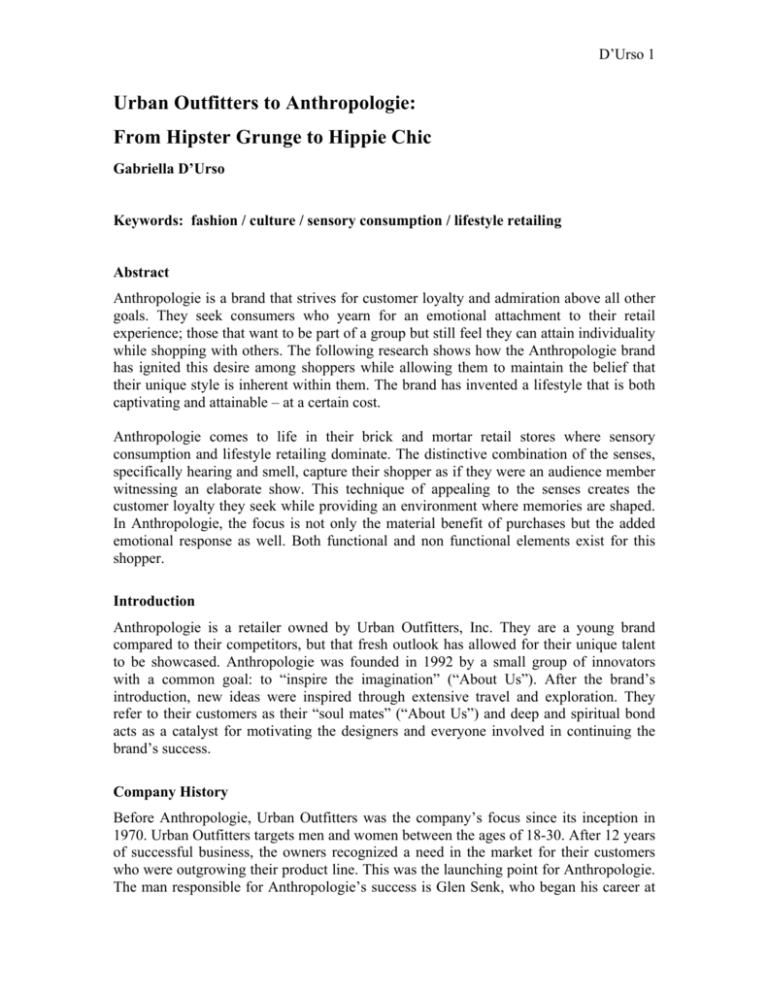
D’Urso 1
Urban Outfitters to Anthropologie:
From Hipster Grunge to Hippie Chic
Gabriella D’Urso
Keywords: fashion / culture / sensory consumption / lifestyle retailing
Abstract
Anthropologie is a brand that strives for customer loyalty and admiration above all other
goals. They seek consumers who yearn for an emotional attachment to their retail
experience; those that want to be part of a group but still feel they can attain individuality
while shopping with others. The following research shows how the Anthropologie brand
has ignited this desire among shoppers while allowing them to maintain the belief that
their unique style is inherent within them. The brand has invented a lifestyle that is both
captivating and attainable – at a certain cost.
Anthropologie comes to life in their brick and mortar retail stores where sensory
consumption and lifestyle retailing dominate. The distinctive combination of the senses,
specifically hearing and smell, capture their shopper as if they were an audience member
witnessing an elaborate show. This technique of appealing to the senses creates the
customer loyalty they seek while providing an environment where memories are shaped.
In Anthropologie, the focus is not only the material benefit of purchases but the added
emotional response as well. Both functional and non functional elements exist for this
shopper.
Introduction
Anthropologie is a retailer owned by Urban Outfitters, Inc. They are a young brand
compared to their competitors, but that fresh outlook has allowed for their unique talent
to be showcased. Anthropologie was founded in 1992 by a small group of innovators
with a common goal: to “inspire the imagination” (“About Us”). After the brand’s
introduction, new ideas were inspired through extensive travel and exploration. They
refer to their customers as their “soul mates” (“About Us”) and deep and spiritual bond
acts as a catalyst for motivating the designers and everyone involved in continuing the
brand’s success.
Company History
Before Anthropologie, Urban Outfitters was the company’s focus since its inception in
1970. Urban Outfitters targets men and women between the ages of 18-30. After 12 years
of successful business, the owners recognized a need in the market for their customers
who were outgrowing their product line. This was the launching point for Anthropologie.
The man responsible for Anthropologie’s success is Glen Senk, who began his career at
D’Urso 2
Bloomingdales and later ran mail order for Williams-Sonoma. He joined Urban Outfitters
in 1994 and began building the Anthropologie brand. Senk’s success stems from his
“healthy disregard for the conventions of retail.” (LaBarre) He states,
"In my experience, retailers spend most of their time looking at
things from the company's perspective or the marketer's perspective
…they talk about trends and brands but rarely about the customer in
a meaningful way. We're customer experts. Our focus is on always
doing what's right for a specific customer we know very well."
(LaBarre)
Anthropologie Today
Anthropologie’s target market is women between the ages of 30-40 who are both affluent
and individuals who want to reflect their unique style with what they wear. Senk goes
beyond the surface and considers their target customer a “friend” (LaBarre). He refers to
her as “well-read and well-traveled. She is very aware – she gets our references, whether
it’s a town in Europe or to a book or a movie. She's urban minded. She's into cooking,
gardening, and wine. She has a natural curiosity about the world. She's relatively fit”
(LaBarre).
Figure 1: 1801 Walnut Street Anthropologie Storefront
Photo courtesy of Gabriella D’Urso. All rights reserved.
Anthropologie sells merchandise ranging from women’s apparel and accessories to home
goods. They sell primarily through their retail store but also do well with sales through
D’Urso 3
their catalog and website. Their assortment is unique and cannot be matched by any other
retailer. Their buyers strive to find actual items that inspire their own designs. The buying
teams travel throughout Europe, India and the U.K. searching antique stores and flea
markets to seek out one-of-a-kind pieces. They distribute these “found objects” within
their assortment, mixing them in with other pieces designed specifically for
Anthropologie (Southerland). This creates a range of product that is unusual and specific
to each store location. Another important concept that adds to the success of their retail
store is its location. They stay away from malls, favoring a spot on the street to get that
“village atmosphere” (Southerland). They prefer to stand alone, rather than in a cluster of
stores.
Anthropologie designs their products with extreme attention to detail and craftsmanship.
Their goal is for the shopper to have a personal experience and relationship to each detail
of every item they find. They design items with the changing world in mind. Their design
and innovation is never stagnant, rather it is fluid and ever changing.
One of Anthropologie’s greatest achievements is their ability to make high end luxury
casual. Even their simplest items have a twist or unique flair about their appearance and
fit. An important differentiating factor about Anthropologie in comparison to their
competitors is that they do not advertise. They prefer to abide by the old fashioned
concept of word-of-mouth as well as natural curiosity to draw customers into the store.
Senk explains, “We spend the money that other companies spend on marketing to create
a store experience that exceeds people's expectations. We don't spend money on
messages -- we invest in execution" (LaBarre). This bold decision has elevated
Anthropologie to the status they enjoy.
Sensory Consumption
Sensory consumption is crucial to brick and mortar retail stores. The experience should
start even before the customer enters the space, like music that can be heard on the street,
or scents that entice customers from blocks away. Sensory consumption sets the mood of
the retail space, which in turn effects every decision made during a shopping trip. This
initial mood must be pleasant or the customer’s experience won’t end well. At
Anthropologie, the focus is on the senses of smell and hearing. As soon as you enter the
retail store the music sets the tone as a calm environment. Anthropologie also has a
signature scent which works with the music to relax their shopper. According to Kim,
Forney and Sullivan, scent is the strongest sense tied to your memory and emotions. This
is a primary reason why shoppers remember their experience and associate either a
positive or negative association which different retailers (“Sensory Consumption”).
These senses create emotion about the products and the overall brand. Lighting, color,
temperature, and touch are other important environmental stimuli that add to the
experience (Kim, Forney and Sullivan, “Sensory Consumption”). Shopping at
Anthropologie is a multi-sensory experience because they use more than one sense to
captivate the shopper. The combination of these senses creates a strong brand-consumer
relationship and experience that transforms into brand loyalty. This process motivates
consumers to become routine shoppers.
D’Urso 4
Anthropologie varies from other retailers because they offer not only physical attributes
to the shopper – the actual product – but they offer non-physical attributes too. Many
other retailers do not understand this distinction. The non-physical attributes as almost
more important than the physical ones, since the customer associates the product with
feel-good emotions and a sense of self improvement on a higher level. These emotions
directly stimulate behavior in buying patterns.
Lifestyle Retailing
Anthropologie is one of the best examples of lifestyle retailing. Not only does the brand
sell apparel, home ware, and accessories but they appeal to their customer’s sense of
well-being as a whole. Lifestyle retailing affects both individual and social identities.
Consumers need both identities fulfilled in order to reach self actualization (Kim, Forney
and Sullivan, “Lifestyle Retailing”). They first need to understand their individual
identity and then their social identity. Retailers have the power to shape and mold these
perceptions. Anthropologie understands the importance of feeling part of a social group,
while still being in tune with your personal identity. That balance must be in harmony.
Once the social identity overtakes the personal understanding of the self, the balance is
lost and the brand has failed. Lifestyle retailers aim to sell a wide variety of product to
their customers, adding convenience to their lives. For the customers, they seek out a
lifestyle that is recognizable and fits with their ideals. Even those who are not aware of
this process fit into a lifestyle that is exemplified by their favorite retailer.
My Trip to Anthropologie
Each person has a different relationship with Anthropologie. Each experience is unique
and offers appeal on an individual level. Some retailers offer a universal experience, and
that is part of their charm. Wal-Mart for example, offers their customer a simple
experience that is familiar every time, leading them to return. One often views their
experience at Wal-Mart as comfortable and recognizable. This benefits them, adding
credibility to their name. In contrast, Anthropologie is one of the few retailers that strives
to differentiate themselves in every way possible. They fall on the other side of the
spectrum from Wal-Mart and other big box retailers. The individual experience they offer
customers serves as a benefit.
In my experience, visiting the Anthropologie flagship store on 1801 Walnut Street is both
stimulating and overwhelming. When first entering the building I am inspired by its
perfect architecture and grand entrance (figure 1). No detail is forgotten - even the door
handle is a majestic iron replica of a tree branch. Once inside, my sensory stimulation
goes wild. From floor to high ceilings, the place is packed full of everything from shelves
of folded t-shirts and racks displaying beautiful dresses to toys and trinkets displayed in a
haphazard, yet elegant, arrangement. The main level brings me in by the staircase, giving
me the choice of traveling upstairs or downstairs. On the main floor I see casual wear
interspersed with delicate jewelry and accessories. There is no strict layout or overly
structured sense of merchandising, yet it is clear that placement is crucial to the customer
D’Urso 5
experience. Items are displayed casually, no one piece given focus over the others. It is
this arrangement that gives every knick knack and trinket authority over the space. The
“found items” are scattered about reminding me to visit the home wares section
downstairs.
Aside from the actual merchandise, even being inside the Anthropologie building is
entertaining. The high ceilings lend themselves to grand display methods; all usually
hand crafted and time consuming endeavors. The current design showcases the beautiful
sense of light the building has by using colorful paper cut into squares and sculpted into
shapes as architectural pieces that enhance the space. This home-crafted feel gives a
simple message, reminding the shopper of home cooked meals and family values. These
traits are not typical of retail spaces. Everything about shopping at Anthropologie is
inspiring on some level, whether it evokes a childhood memory or encourages plans for
the future.
Figure 2: Display featuring dresses and tank tops
Photo courtesy of Gabriella D’Urso. All rights reserved.
The three other levels within the store are connected by a grand spiral staircase complete
with landings displaying 7 foot tall mirrors and collections of candlesticks. Downstairs on
the bottom level I find the home wares section and the saleroom (figures 2, 3). To the
right is a charming nature-inspired nook with stuffed animals and children’s books
huddle under a magnificent chandelier used only for decoration. This nook is a pleasant
getaway from the rest of the store. It is there to comfort the shopper and evoke nostalgia
(although of course the items are for sale too!). This area blends into the home ware
section with mismatched doorknobs and salt and peppershakers shaped as barnyard
animals.
D’Urso 6
Figure 3: Display featuring home ware items
Photo courtesy of Gabriella D’Urso. All rights reserved.
Back upstairs on the third floor, things are a bit smaller. Displays up here are simpler mostly tables with folded items and hanging racks behind them. On the fourth floor I find
the bedding and sleepwear collections as well as the fitting rooms. This floor is perhaps
the largest, allowing for full size beds to be dressed in featured bedding. Other furniture
is displayed too, ranging from a cozy armchair to a vintage-inspired replica of a wooden
toilet. These grand pieces are interspersed with delicate nightgowns and robes along with
a collection of perfumes and lotions. Even the music is adapted for this floor. It is
dreamlike and slow, with a lounge-like edge.
Figure 3: Decorative Chandelier
Photo courtesy of Gabriella D’Urso. All rights reserved.
D’Urso 7
Leaving the Anthropologie store is like leaving a fantasy land – it is difficult to do. It
seems there is always something more to experience. It is that lasting feeling that draws
customers back every time. They seek that relaxation and intellectual stimulation from
their shopping environment. Anthropologie is seen as a getaway; as a departure from the
typical shopping experience where the goal of the retailer is to yield as much profit as
possible.
Conclusion
Anthropologie’s success has come from years of studying customer behaviors and
lifestyles but the result is not a brand that is calculated and conformist. It is a brand that
understands their sense of self and their unique placement in the retail world. Within the
confines of who they are as a brand, they have found movement and possibility and
opportunity for the future.
D’Urso 8
Works Cited
“About Us.” Anthropologie.com. Anthropologie, n.d. Web. 10 May 2009.
LaBarre, Polly. "Sophisticated Sell." FastCompany.com. 19 Dec. 2007. Web. 10 May
2009.
Kim, Youn-kyung, Judith Cardona Forney, and Pauline Sullivan. “Sensory
Consumption.” Experiential Retailing: Concepts and Strategies That Sell. New
York: Fairchild Publications, 2007. 159-194. Print.
Kim, Youn-kyung, Judith Cardona Forney, and Pauline Sullivan. “Lifestyle Retailing.”
Experiential Retailing: Concepts and Strategies That Sell. New York: Fairchild
Publications, 2007. 273-301. Print.
Southerland, Randy. "Anthropologie's Cultured Approach to Style.”
Retailtrafficmag.com. Penton Media Inc., 1 July 2000. Web. 10 May 2009.

